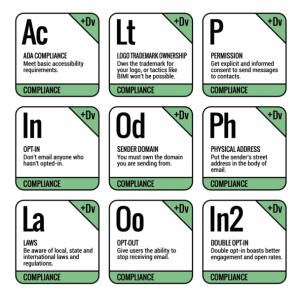— July 12, 2018

Are you lacking a viable social media strategy? If so, you aren’t alone. 50% of businesses claim that they lack a tangible social media strategy, according to a recent survey. Accordingly, many businesses feel that having a documented social media strategy is unnecessary and takes a lot of time to create. Unfortunately, both of these points are utterly untrue. In order to properly analyze your social media growth and take a strategic approach to conquering social media in your niche, developing a social media strategy that outlines your objectives is definitely in order.
Read on to learn about 9 easy steps you can take to craft a social media strategy for your business.
Step 1: Craft an Executive Summary
All social media strategies begin with an executive summary, or simply a summary that describes your overall objective and how it relates to your business goals. The executive summary should be about one-page long and succinctly identify your purpose for using social media. Furthermore, this summary should include specific goals you are trying to achieve on a particular social media channel.
Overall, keep your executive summary clear and concise to ensure that your team defines growth and success in the same way as you.
Example: Grow my Facebook followers by 25%
Step 2: Conduct a Social Media Audit
As the old saying goes, “Keep your friends close but your enemies closer.” The same maxim applies to your social media strategy. As such, conduct a social media audit of your primary social channels compared to two or three of your competitors. You may also elect to compare your social channels to a large non-competitor, such as Starbucks or Cisco, to use for inspiration.
When you are striking comparisons, be mindful to look at factors such as content, frequency, engagement, video use, visuals, customer service messaging, and tone, and audience size. You can also consult any additional factors that include,
- Reviews
- Third-Party Content
- Keywords
- Hashtags and Emoji Use
Measurements of engagement, which include all of these factors, encourages both small and large businesses that their social media strategy is either working or failing. To keep tabs on your engagement measurements, use Google Analytics to check your social media statistics, such as page views and click-through rates (CTR).
Step 3: Focus on Your Objectives
Now that you have studied the metrics of your competitors, it’s time to begin outlining your objectives. To give you the full run-down on how you should format this section, here is a complete breakdown of the categories that should be added in your social media strategy.
- Goals: These are the outcomes you want to happen.
- Strategy: This is the committed approach you will use to accomplish your goal.
- Objectives: These are measurable steps you will take to ensure that the strategy is duly carried out.
- Tactics: These are simply the tasks or tools required to complete an objective related to the strategy.
As you can see, these factors are conjoined throughout your social media strategy. Here is a perfect example of how you should include these factors in your own documented strategy.
- Goal: Obtain a large Facebook audience for our business.
- Strategy: Increase the amount of publishable content, interact with the audience, and share user-generated content.
- Objective: Increase Facebook followers by 25%.
- Tactics: Through interaction with influencers, leverage the exposure through visual and creative content, adjustable advertising budgets for boosted posts, and Facebook Stories.
Step 4: Create a Buyer Persona
It’s no secret that brands need personas to relate to consumers. Buyer personas should relate to the audience you strive to sell your products or services to. For example, Apple continually develops brilliant advertisements that depict how their products are ideal for professionals, business people, and millennial. By understanding who their target audience is, Apple creates commercials showing why these individuals need their products.
Creating your own buyer persona is essential to creating valuable content for your target audience. To get started, use products such as Xtensio Persona Maker and Hubspot’s Make My Persona to develop your ideal Buyer Persona.
Step 5: Adjust Your Buyer Persona
Once you have developed your buyer persona, you have to adjust it to your social media profiles. Simply, who are you? How do you want your audience to view your brand? Are you coy, playful, or fun? Maybe your brand is more serious and hates emojis. Whatever the case may be, adjust your buyer persona to your audience and be prepared to stick with it for a long time.
Step 6: Take Advantage of Your Resources
In this step, you will finally be able to put your strategy into action. To properly put your strategy into an initiative, implement the use of the paid, earned, and owned strategy. Are you confused on where to start? Here’s a great example.
- Paid: Increase the engagements of your content by boosting a post every week. Ideally, publish your post first and wait a few days before giving it a boost.
- Owned: Introduce your very own branded hashtag and begin promoting it on other social media channels, your posts, and even encourage popular influencers to use it.
- Earned: Social media is loaded with members of the media, bloggers, and influencers. Find conversations you are interested in, and take part in it. Doing so will increase your exposure and convince others that you are important and popular in your niche.
Step 7: Measure Your Growth
It’s often easy to get lost in a variety of growth metrics, reports, and audits, while you are trying to find out how your brand is growing on social media. Instead of worrying about this fluctuating data, here are two ways to measure your social media growth.
- Quantitative: This is simply data that you can measure quantitatively with numbers. Impressions, followers, and website sessions are examples of quantitative data.
- Qualitative: This data is intangible, but nonetheless important for your business. Positive comments and reviews can indicate that you are providing exceptional products and services.
Conclusion:
Once you are done following these steps, what are you supposed to do next? In actuality, the answer should be different for everyone. Nevertheless, you should obtain a general (and documented) understanding of your social media objectives. Now that you have a social media strategy, it’s simply up to you to put it into effect for your brand.
Did you find this article to be helpful? If so, feel free to share this article on Twitter, Facebook, and any other social media channels.
Digital & Social Articles on Business 2 Community
(61)






